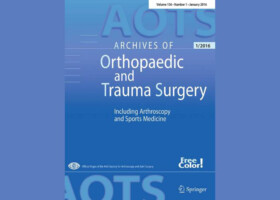
Authors:
Maximilian Petri, Simon A. Euler, Grant J. Dornan, Joshua A. Greenspoon, Marilee P. Horan, J. Christoph Katthagen, Peter J. Millett
Abstract:
The use of total shoulder arthroplasty (TSA) to treat symptomatic glenohumeral osteoarthritis (GHOA) is increasing. In 2008, approximately 27,000 TSAs were performed in the United States, 77 % of which were done to manage GHOA. Several studies have revealed better results and a lower revision rate for TSA compared to hemiarthroplasty for treatment of primary GHOA. The most common causes for failure or complications following TSA are prosthetic loosening, glenohumeral instability, periprosthetic fracture, rotator cuff tears, infection, neural injury, and deltoid muscle dysfunction. Overall reported complication rates after TSA vary between 3 and 22.6 %. Secondary surgery rates have been reported ranging from 6.5 to 11.2 %. Even though long-term revision-free survival rates of primary TSA are reportedly high, 95 % at 10 years and 83.2 % at 20 years, the identification of preoperative factors affecting outcomes is lacking in the literature.
Chen reported a significant correlation between patients’ age and satisfaction after TSA as well as a significant correlation between satisfaction and the ASES score. In addition to female gender, the abnormal glenoid morphology as defined by the Walch classification has been associated with inferior TSA outcomes. It has been reported that patients with glenoid type B according to the Walch classification involving posterior subluxation of the humeral head are at increased risk for complications and failure due to recurrent instability and early glenoid loosening. Johnson et al. recently found that the overall patient’s preoperative health as measured by the American Society of Anesthesiologists (ASA, scale 1–6) score greater than 2 significantly increased the risk for surgical complications in TSAs, reverse TSAs, and revision arthroplasties, with a three times increased risk for prosthesis failure. Harreld et al. demonstrated that patient satisfaction after TSA correlated more with subjective than objective measures such as the ASES score, Simple Shoulder Test, and SF-36 summary scores. They concluded that subjective measures had a relatively low correlation with objective measures.
The purpose of this study was to analyze predictors for satisfaction after anatomic TSA for primary idiopathic GHOA. According to previously published variables, the hypothesis was that men, older age, no prior surgeries, ASA score of 1 or 2 (compared to 3 or more), and Walch glenoids A1 and A2 with centered humeral head (compared to B1 and B2 glenoids with posterior subluxation of the humeral head) would be predictors of patient satisfaction after TSA.
For the complete study: Predictors for satisfaction after anatomic total shoulder arthroplasty for idiopathic glenohumeral osteoarthritis
